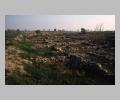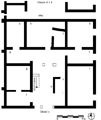| Context: | Olynthus |
| Type: | House |
| Summary: | House on the North Hill of Olynthus, with shops and olive press. |
| Date: | ca. 432 BC - ca. 348 BC |
| Dimensions: | 17.40 x 16.85 m. |
| Period: | Classical/Late Clas. |
Plan:
Domestic portion of house fairly regular in plan, with courtyard, pastas, kitchen complex. Three shops take up much of the eastern part of the house. Probably had a second story.
Date Description:
Not built before 432 BC, when this part of Olynthus was planned and laid out; destroyed by Philip II in 348 BC.
Other Notes:
House A v 10 is rather similar in plan to house
The open court was fairly small, only 3.5 x 3.8 m., and was drained to the south by a drain made of stone slabs. South of the paved court was an unpaved area which must have been a covered exedra, its roof supported by a single base. The area northeast of the court was also roofed. Together, these three areas seem to have seen a wide range of activities.
The court or exedra contained a large fragment of an olive crusher or orbis. The stone was broken and there was no trace of the rest of the crushing apparatus; but while we cannot be completely certain that this stone was part of a complete machine set up here, the wide double doorway into the house, appropriate for carts and heavy loads and found in many houses where agricultural products were processed, and the findspot of the piece on the floor of the court or exedra, where such a machine would most likely have been set up, help confirm the significance of this fragment. Probably the less damaged pieces were salvaged and reused after the destruction. Two terracotta louters found here might also have been used in olive crushing.
Two groups of loomweights, one containing 23 weights, the other 38, document weaving somewhere in the house, but the room(s) in which they were found were not recorded.
Unlike some houses at Olynthus such as the
The kitchen complex (rooms b, c and the unlabeled bathroom) is slightly irregular in design, the wall dividing the bath from the flue being skew, and the flue having a door into the kitchen rather than into the pastas or court, as is usually the case. As so often, the kitchen contained only a few, rather miscellaneous finds: a fragment of a bronze grater, a lamp, a saucer, a few pieces of hardware. A number of fragments of a bathtub were found in the bath and more in the flue.
As in house
The northern shop (d) contained a hoard of ten bronze coins and sixteen other scattered coins, not from the hoard. As in the shops of
The middle shop contained few finds, and was perhaps more of an entrance and anteroom than a shop per se. The southern shop, however, contained two more styli, eight coins, and a lead weight, an assemblage similar to that of the northern shop. The shop also contained a number of tablewares and coarse vases, seven loomweights, a large terracotta female head, a knife and a spearhead, and other domestic and miscellaneous objects.
A sales inscription found in room g records that Dionysius, son of Ithyras bought this house, together with the storeroom (
Domestic functions are not as well documented in this house as in some others, perhaps because it was excavated somewhat hastily. But the scarcity of equipment in the pastas and kitchen complex is probably not due simply to poor preservation or excavation; it rather suggests a different form of organization. Instead of the pastas, the court and roofed exedra took over some domestic functions. The site(s) of weaving are uncertain, but the household certainly produced its own cloth, as was normal in a Greek household.
Most interesting, however, is the variety of other sorts of work that went on in the house. An olive crusher is too great an investment for most houses to have made or needed; just like today, only a few specialists in the community actually owned such expensive machinery, and most olive growers would have rented time on the equipment when their olives were harvested (Forbes & Foxhall conservatively estimate one press per ten households in antiquity [Expedition 21 (1978) 37-47]). This house, like a number of houses in Row A and elsewhere, seems to have specialized in such agricultural processing, and been built accordingly, with wide double doors able to accommodate carts and beasts of burden. The absence of a press to extract the oil from the crushed olive pulp is not too surprising, since these could be made of wood and leave few traces.
The shops might have been part of this agricultural processing or perhaps involved with another side of the family business. The sales inscription associates
Sources Used:




